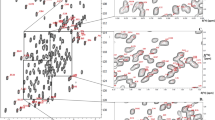Abstract
The H-NOX (Heme-nitric oxide/oxygen binding) domain is conserved across eukaryotes and bacteria. In human soluble guanylyl cyclase (sGC) the H-NOX domain functions as a sensor for the gaseous signaling agent nitric oxide (NO). sGC contains the heme-binding H-NOX domain at its N-terminus, which regulates the catalytic site contained within the C-terminal end of the enzyme catalyzing the conversion of GTP (guanosine 5′-triphosphate) to GMP (guanylyl monophosphate). Here, we present the backbone and side-chain assignments of the 1H, 13C and 15N resonances of the 183-residue H-NOX domain from Nostoc sp. through solution NMR.


Similar content being viewed by others
Abbreviations
- NMR:
-
Nuclear Magnetic Resonance
- HSQC:
-
Heteronuclear single quantum coherence
- H-NOX:
-
Heme–nitric oxide/oxygen binding domain
- sGC:
-
Soluble guanylyl cyclase
References
Ashman DF, Lipton R, Melicow MM, Price TD (1963) Isolation of adenosine 3′, 5′-monophosphate and guanosine 3′, 5′-monophosphate from rat urine. Biochem Biophys Res Commun 11:330–334
Bartels C, Xia TH, Billeter M, Guntert P, Wuthrich K (1995) The program XEASY for computer-supported NMR spectral analysis of biological macromolecules. J Biomol NMR 6:1–10
Behrends S (2003) Drugs that activate specific nitric oxide sensitive guanylyl cyclase isoforms independent of nitric oxide release. Curr Med Chem 10:291–301
Boon EM, Marletta MA (2005a) Ligand discrimination in soluble guanylate cyclase and the H-NOX family of heme sensor proteins. Curr Opin Chem Biol 9:441–446
Boon EM, Marletta MA (2005b) Ligand specificity of H-NOX domains: from sGC to bacterial NO sensors. J Inorg Biochem 99:892–902
Boon EM, Davis JH, Tran R, Karow DS, Huang SH, Pan D, Miazgowicz MM, Mathies RA, Marletta MA (2006) Nitric oxide binding to prokaryotic homologs of the soluble guanylate cyclase beta1 H-NOX domain. J Biol Chem 281:21892–21902
Buechler WA, Ivanova K, Wolfram G, Drummer C, Heim JM, Gerzer R (1994) Soluble guanylyl cyclase and platelet function. Ann N Y Acad Sci 714:151–157
Chasapis CT, Argyriou AI, Corringer PJ, Bentrop D, Spyroulias GA (2011) Unravelling the conformational plasticity of the extracellular domain of a prokaryotic nAChR homologue in solution by NMR. Biochemistry 50:9681–9683
Denninger JW, Marletta MA (1999) Guanylate cyclase and the NO/cGMP signaling pathway. Biochim Biophys Acta 1411:334–350
Erbil WK, Price MS, Wemmer DE, Marletta MA (2009) A structural basis for H-NOX signaling in Shewanella oneidensis by trapping a histidine kinase inhibitory conformation. Proc Natl Acad Sci USA 106:19753–19760
Evgenov OV, Pacher P, Schmidt PM, Hasko G, Schmidt HH, Stasch JP (2006) NO-independent stimulators and activators of soluble guanylate cyclase: discovery and therapeutic potential. Nat Rev Drug Discov 5:755–768
Gerzer R, Bohme E, Hofmann F, Schultz G (1981) Soluble guanylate cyclase purified from bovine lung contains heme and copper. FEBS Lett 132:71–74
Gerzer R, Radany EW, Garbers DL (1982) The separation of the heme and apoheme forms of soluble guanylate cyclase. Biochem Biophys Res Commun 108:678–686
Hardman JG, Robison GA, Sutherland EW (1971) Cyclic nucleotides. Annu Rev Physiol 33:311–336
Herzik MA Jr, Jonnalagadda R, Kuriyan J, Marletta MA (2014) Structural insights into the role of iron-histidine bond cleavage in nitric oxide-induced activation of H-NOX gas sensor proteins. Proc Natl Acad Sci USA 111:E4156–E4164
Iyer LM, Anantharaman V, Aravind L (2003) Ancient conserved domains shared by animal soluble guanylyl cyclases and bacterial signaling proteins. BMC Genom 4:5
Keller R (2004) The Computer Aided Resonance Assignment Tutorial CH-6410. Cantina Verlag, Goldau
Koesling D, Russwurm M, Mergia E, Mullershausen F, Friebe A (2004) Nitric oxide-sensitive guanylyl cyclase: structure and regulation. Neurochem Int 45:813–819
Kumar V, Martin F, Hahn MG, Schaefer M, Stamler JS, Stasch JP, van den Akker F (2013) Insights into BAY 60-2770 activation and S-nitrosylation-dependent desensitization of soluble guanylyl cyclase via crystal structures of homologous nostoc H-NOX domain complexes. Biochemistry 52:3601–3608
Ma X, Sayed N, Beuve A, van den Akker F (2007) NO and CO differentially activate soluble guanylyl cyclase via a heme pivot-bend mechanism. EMBO J 26:578–588
Ohlstein EH, Wood KS, Ignarro LJ (1982) Purification and properties of heme-deficient hepatic soluble guanylate cyclase: effects of heme and other factors on enzyme activation by NO, NO-heme, and protoporphyrin IX. Arch Biochem Biophys 218(1):187–198
Poulos TL (2006) Soluble guanylate cyclase. Curr Opin Struct Biol 16(6):736–743
Pyriochou A, Papapetropoulos A (2005) Soluble guanylyl cyclase: more secrets revealed. Cell Signal 17(4):407–413
Robison GA, Butcher RW, Sutherland EW (1968) Cyclic AMP. Annu Rev Biochem 37:149–174
Russwurm M, Koesling D (2004) Guanylyl cyclase: NO hits its target. Biochem Soc Symp 71:51–63
Schubert M, Labudde D, Oschkinat H, Schmieder P (2002) A software tool for the prediction of Xaa-Pro peptide bond conformations in proteins based on 13C chemical shift statistics. J Biomol NMR 24(2):149–154
Shen Y, Delaglio F, Cornilescu G, Bax A (2009) TALOS+: a hybrid method for predicting protein backbone torsion angles from NMR chemical shifts. J Biomol NMR 44(4):213–223
Tsai AL, Berka V, Martin F, Ma X, van den Akker F, Fabian M, Olson JS (2010) Is Nostoc H-NOX a NO sensor or redox switch? Biochemistry 49:6587–6599
Winter MB, Herzik MA Jr, Kuriyan J, Marletta MA (2011) Tunnels modulate ligand flux in a heme nitric oxide/oxygen binding (H-NOX) domain. Proc Natl Acad Sci USA 108(43):E881–E889
Wüthrich, K. (1986) NMR of Proteins and Nucleic Acids. Wiley, New York
Acknowledgments
"SEE-DRUG" Grant (EU FP7 REGPOT CT-2011-285950; www.seedrug.upatras.gr) is acknowledged for financial support.
Author information
Authors and Affiliations
Corresponding author
Additional information
Ioannis I. Alexandropoulos and Aikaterini I. Argyriou have contributed equally to this work.
Rights and permissions
About this article
Cite this article
Alexandropoulos, I.I., Argyriou, A.I., Marousis, K.D. et al. 1H, 13C, 15N backbone and side-chain resonance assignment of Nostoc sp. C139A variant of the heme–nitric oxide/oxygen binding (H-NOX) domain. Biomol NMR Assign 10, 395–400 (2016). https://doi.org/10.1007/s12104-016-9707-6
Received:
Accepted:
Published:
Issue Date:
DOI: https://doi.org/10.1007/s12104-016-9707-6




